Species Diversity of Deadwood in Chinese Fir Plantations Differs between Mixed Planting and Thinning Treatments
Abstract
1. Introduction
2. Materials and Methods
2.1. Study Area
2.2. Test Design and Plot Establishment
2.3. Data Analysis
2.3.1. Extraction of Terrain Factors
2.3.2. Species Diversity
3. Results
3.1. Species Composition of Deadwood
3.2. Species Diversity of Deadwood
3.3. Correlations between Topographic Factors and Deadwood Distribution
3.4. Correlations between Topographic Factors and Deadwood Species Diversity
4. Discussion
5. Conclusions
Supplementary Materials
Author Contributions
Funding
Institutional Review Board Statement
Informed Consent Statement
Data Availability Statement
Acknowledgments
Conflicts of Interest
References
- FAO. The State of the World’s Forests 2018—Forest Pathways to Sustainable Development; FAO: Rome, Italy, 2018. [Google Scholar]
- Li, Y.; Xu, J.; Wang, H.; Nong, Y.; Sun, G.; Yu, S.; Liao, L.; Ye, S. Long-term effects of thinning and mixing on stand spatial structure: A case study of Chinese fir plantations. iForest 2021, 14, 113–121. [Google Scholar] [CrossRef]
- Huang, S.; Lin, S.; Cao, G.; Wu, S.; Chen, J. Primary study on the characteristics of species diversity in Chinese-fir and broad-leaved mixed forests in different habitats. Biodivers. Sci. 2001, 9, 162–167. [Google Scholar]
- Cai, D.; Lu, L.; Jia, H.; He, R. The influence of closing for afforestation on vegetation diversity restoration under Chinese fir plantation. For. Res. 2007, 20, 319–327. [Google Scholar]
- Holuša, J.; Lubojacký, J.; Čurn, V.; Tonka, T.; Lukášová, K.; Horák, J. Combined effects of drought stress and Armillaria infection on tree mortality in Norway spruce plantations. For. Ecol. Manag. 2018, 427, 434–445. [Google Scholar] [CrossRef]
- Chiara, L.; Hans, H.B.; Alessandro, C.; Davide, D.; Fabrizio, F.; Örjan, F.; Irina, G.; Juri, N.; Anders, P.T.; Carsten, R.; et al. Biodiversity response to forest structure and management: Comparing species richness, conservation relevant species and functional diversity as metrics in forest conservation. For. Ecol. Manag. 2019, 432, 707–717. [Google Scholar]
- Li, Y.; He, J.; Lu, L.; Xu, J.; Wang, H.; Ye, S. The long-term effects of thinning and mixing on species and structural diversity of Chinese fir plantations. New For. 2020, 52, 285–302. [Google Scholar] [CrossRef]
- Cheesman, A.; Preece, N.; Oosterzee, P.; Erskine, P.; Cernusak, L. The role of topography and plant functional traits in determining tropical. J. Appl. Ecol. 2018, 55, 1029–1039. [Google Scholar] [CrossRef]
- Hilmers, T.; Biber, P.; Knoke, T.; Pretzsch, H. Assessing transformation scenarios from pure Norway spruce to mixed uneven-aged forests in mountain areas. Eur. J. For. Res. 2020, 139, 567–584. [Google Scholar] [CrossRef]
- Zhang, H.; Zhou, G.; Wang, Y.; Bai, S.; Sun, Z.; Berninger, F.; Bai, Y.; Penttinen, P. Thinning and species mixing in Chinese fir monocultures improve carbon sequestration in subtropical China. Eur. J. For. Res. 2019, 138, 433–443. [Google Scholar] [CrossRef]
- Li, Y.; Li, M.; Li, X.; Liu, Z.; Ming, A.; Lan, H.; Ye, S. The abundance and structure of deadwood: A comparison of mixed and thinned Chinese fir plantations. Front. Plant Sci. 2021, 12, 614695. [Google Scholar] [CrossRef]
- Spracklen, B.D.; Lane, J.V.; Spracklen, D.V.; Williams, N.; Kunin, W.E. Regeneration of native broadleaved species on clearfelled conifer plantations in upland Britain. For. Ecol. Manag. 2013, 310, 204–212. [Google Scholar] [CrossRef]
- Wang, D.; Olatunji, O.A.; Xiao, J. Thinning increased fine root production, biomass, turnover rate and understory vegetation yield in a Chinese fir plantation. For. Ecol. Manag. 2019, 440, 92–100. [Google Scholar] [CrossRef]
- Sweeney, O.F.M.; Martin, R.D.; Irwin, S.; Kelly, T.C.; O’Halloran, J.; Wilson, M.W.; McEvoy, P.M. A lack of large-diameter logs and snags characterises dead wood patterns in Irish forests. For. Ecol. Manag. 2010, 259, 2056–2064. [Google Scholar] [CrossRef]
- Nagaike, T. Snag abundance and species composition in a managed forest landscape in Central Japan composed of Larix kaempferi plantations and secondary broadleaf forests. Silva Fenn. 2009, 43, 755–766. [Google Scholar] [CrossRef]
- Paletto, A.; Agnelli, A.E.; De, M.I. Carbon Stock in Deadwood: The Mountain Birch (Betula pubescens subsp. czerepanovii) Forests in the Khibiny Mountains (Russia). J. Sustain. For. 2020, 40, 385–400. [Google Scholar] [CrossRef]
- Lu, M.Z.; Du, H.; Song, T.Q.; Peng, W.X.; Su, L.; Zhang, H.; Zeng, Z.X.; Wang, K.L.; Tang, W.N.; Wei, L.; et al. Drivers of tree survival in an evergreen-deciduous broadleaf karst forest in southwest China. For. Ecol. Manag. 2021, 499, 119598. [Google Scholar] [CrossRef]
- Sun, S.; He, C.; Qiu, L.; Li, C.; Zhang, J.; Meng, P. Stable isotope analysis reveals prolonged drought stress in poplar plantation mortality of the Three-North Shelter Forest in Northern China. Agric. For. Meteorol. 2018, 252, 39–48. [Google Scholar] [CrossRef]
- Feng, Z.; Chen, C.; Zhang, J.; Zeng, S.; Luo, R.; Chen, W. A coniferous broad-leaved mixed forest with higher productivity and ecological harmony in subtropics-study on mixed forest of Cunninghamia lanceolata and Michelia macclurei. Acta Phytoecol. Geobot. Sin. 1988, 12, 165–180. [Google Scholar]
- Chen, C.; Zhang, J.; Zhou, C.; Zheng, H. Researches on improving the quality of forest land and the productivity of artificial Cunninghamia lanceolata stands. J. Appl. Ecol. 1990, 1, 97–106. [Google Scholar]
- Li, M.; Ritchie, G.A. Eight hundred years of clonal forestry in China: II. mass production of rooted cuttings of Chinese fir (Cunninghamia lanceolata (Lamb.) Hook.). New For. 1999, 18, 143–159. [Google Scholar]
- Ma, X.; Heal, K.V.; Liu, A.; Jarvis, P.G. Nutrient cycling and distribution in different-aged plantations of Chinese fir in southern China. For. Ecol. Manag. 2007, 243, 61–74. [Google Scholar] [CrossRef]
- Sheng, W.; Xue, X. Comparisons between pure stands of Chinese fir, Fukien cypress and mixed stands of these two species in growth, structure, biomass and ecological effects. Sci. Silvae Sin. 1992, 28, 397–404. [Google Scholar]
- Tian, D.; Xiang, W.; Chen, X.; Yan, W.; Fang, X.; Kang, W.; Dan, X.; Peng, C.; Peng, Y. A long–term evaluation of biomass production in first and second rotations of Chinese fir plantations at the same site. Forestry 2011, 84, 411–418. [Google Scholar] [CrossRef]
- Farooq, T.; Wu, W.; Tigabu, M.; Ma, X.; He, Z.; Rashid, M.; Gilani, M.; Wu, P. Growth, Biomass Production and Root Development of Chinese fir in Relation to Initial Planting Density. Forests 2019, 10, 236. [Google Scholar] [CrossRef]
- Ming, A.G.; Yang, Y.J.; Liu, S.R.; Nong, Y.; Tao, Y.; Zeng, J.; An, N.; Niu, C.H.; Zhao, Z.; Jia, H.Y.; et al. A decade of close-to-nature transformation alters species composition and increases plant community diversity in two coniferous plantations. Front. Plant Sci. 2020, 11, 1141. [Google Scholar] [CrossRef]
- Zhou, L.L.; Shalom, A.D.D.; Wu, P.F.; He, Z.M.; Liu, C.H.; Ma, X.Q. Biomass production, nutrient cycling and distribution in age-sequence Chinese fir (Cunninghamia lanceolate) plantations in subtropical China. J. For. Res. 2016, 27, 357–368. [Google Scholar] [CrossRef]
- Zhang, Q.; Wang, S.; Huang, Y.; Yao, X.; He, X.; Ye, S. Ecological stoichiometry of soil carbon, nitrogen, and phosphorus within soil aggregates of four plantations in different Cunninghamia lanceolata stand types. Acta Bot. Sin. 2021, 41, 1028–1035. [Google Scholar]
- Huang, Y.; Wang, S.; Ye, S. Effects of Cunninghamia lanceolata stand types on the changes of aggregate-related organic carbon and nutrients in surface soil. Chin. J. Appl. Ecol. 2020, 31, 2857–2865. [Google Scholar]
- Oksanen, J.; Blanchet, F.; Friendly, M.; Kindt, R.; Legendre, P.; McGlinn, D.; Minchin, P.; O’Hara, R.; Simpson, G.; Solymos, P.; et al. Vegan: Community Ecology Package. Available online: https://CRAN.R-project.org/package=vegan (accessed on 25 December 2021).
- Lepš, J.; Šmilauer, P. Multivariate Analysis of Ecological Data Using CANOCO 5; Cambridge University Press: Cambridge, UK, 2003. [Google Scholar]
- Hosseinzadeh, R.; Soosani, J.; Alijani, V.; Khosravi, S.; Karimikia, H. Diversity of woody plant species and their relationship to physiographic factors in central Zagros forests (Case study: Perc forest, Khorramabad, Iran). J. For. Res. 2016, 27, 1137–1141. [Google Scholar] [CrossRef]
- Cheng, C.; Wang, Y.; Fu, X.; Xu, M.; Dai, X.; Wang, H. Thinning effect on understory community and photosynthetic characteristics in a subtropical Pinus massoniana plantation. Can. J. For. Res. 2017, 47, 1104–1115. [Google Scholar] [CrossRef]
- Grove, S.J. Extent and composition of dead wood in Australian lowland tropical rainforest with different management histories. For. Ecol. Manag. 2001, 154, 35–53. [Google Scholar] [CrossRef]
- Parisi, F.; Innangi, M.; Tognetti, R.; Lombardi, F.; Chirici, G.; Marco, M. Forest stand structure and coarse woody debris determine the biodiversity of beetle communities in Mediterranean mountain beech forests. Glob. Eco. Conserv. 2021, 28, e01637. [Google Scholar] [CrossRef]
- Vítková, L.; Bače, R.; Kjučukov, P.; Svoboda, M. Deadwood management in Central European forests: Key considerations for practical implementation. For. Ecol. Manag. 2018, 429, 394–405. [Google Scholar] [CrossRef]
- Doerfler, I.; Müller, J.; Gossner, M.M.; Hofner, B.; Weisser, W.W. Success of a deadwood enrichment strategy in production forests depends on stand type and management intensity. For. Ecol. Manag. 2017, 400, 607–620. [Google Scholar] [CrossRef]
- Liu, S.; Dai, L.; Wen, Y.; Wang, H. A review on forest ecosystem management towards ecosystem services: Status, challenges, and future perspectives. Acta Ecol. Sin. 2015, 35, 1–9. [Google Scholar]
- Harvey, B.D.; Brais, S. Partial cutting as an analogue to stem exclusion and dieback in trembling aspen (Populus tremuloides) dominated boreal mixedwoods: Implications for deadwood dynamics. Can. J. For. Res. 2007, 37, 1525–1533. [Google Scholar] [CrossRef]
- Nguyen, H.; Vanclay, J.; Herbohn, J.; Firn, J. Drivers of tree growth, mortality and harvest preferences in species-rich plantations for smallholders and communities in the tropics. PLoS ONE. 2016, 11, e0164957. [Google Scholar] [CrossRef]
- He, Z.; Yang, Y.; Zheng, Z. Difference in growth process of Chinese fir between Chinese fir-Tsoongiodendron odorum mixed plantation and pure Chinese fir plantation. Sci. Silvae Sin. 2001, 37, 126–130. [Google Scholar]
- Wilson, D.S.; Puettmann, K.J. Density management and biodiversity in young Douglas-fir forests: Challenges of managing across scales. For. Ecol. Manag. 2007, 246, 123–134. [Google Scholar] [CrossRef]
- Otto, R.; García-del-Rey, E.; Méndez, J.; Fernández-Palacios, J.M. Effects of thinning on seed rain, regeneration and understory vegetation in a Pinus canariensis plantation (Tenerife, Canary Islands). For. Ecol. Manag. 2012, 280, 71–81. [Google Scholar] [CrossRef]
- Kitagawa, R.; Ueno, M.; Masaki, T.; Verheyen, K. Thinning affects understory tree community assembly in monoculture plantations by facilitating stochastic immigration from the landscape. Appl. Veg. Sci. 2017, 20, 673–682. [Google Scholar] [CrossRef]
- Fan, S.; Ma, X.; Fu, R.; Liu, A. Comparative study on underground vegetation develop of different generation plantations of Chinese fir. For. Res. 2001, 14, 9. [Google Scholar]
- Jiao, R.; Yang, C.; Tu, X.; Sheng, W. The change of undergrowth, soil microorganism, enzyme activity and nutrient in different developing stage of the Chinese fir plantation. For. Res. 1997, 10, 373–379. [Google Scholar]
- Lin, K.; Yu, x.; Huang, B.; He, Z. Dynamic characteristics of undergrowth plant diversity in Chinese fir plantations. Chin. J. Appl. Environ. Biol. 2001, 7, 13–19. [Google Scholar]
- Lin, K.; Huang, B. Studies on β-diversity index of undergrowth plant in Chinese fir plantation. Biodiv. Sci. 2001, 9, 157–161. [Google Scholar]
- Sheng, W. A study on stand density management and long term productive of Chinese fir (Cunninghamia lanceolata) plantation. Sci. Silvae Sin. 2001, 37, 2–9. [Google Scholar]
- Lu, D.L.; Wang, G.G.; Zhang, J.X.; Fang, Y.T.; Zhu, C.Y.; Zhu, J.J. Converting larch plantations to mixed stands: Effects of canopy treatment on the survival and growth of planted seedlings with contrasting shade tolerance. For. Ecol. Manag. 2018, 409, 19–28. [Google Scholar] [CrossRef]
- Harrington, T.B. Overstory and understory relationships in longleaf pine plantations 14 years after thinning and woody control. Can. J. For. Res. 2011, 41, 2301–2314. [Google Scholar] [CrossRef]
- Trentini, C.P.; Campanello, P.I.; Villagra, M.; Ritter, L.; Ares, A.; Goldstein, G. Thinning of loblolly pine plantations in subtropical Argentina: Impact on microclimate and understory vegetation. For. Ecol. Manag. 2017, 384, 236–247. [Google Scholar] [CrossRef]
- Kirby, K.J.; Reid, C.M.; Thomas, R.C.; Goldsmith, F.B. Preliminary estimates of fallen dead wood and standing dead trees in managed and unmanaged forests in Britain. J. Appl. Ecol. 1998, 35, 148–155. [Google Scholar] [CrossRef]
- Franklin, J.F.; Mitchell, R.J.; BJ, P. Natural Disturbance and Stand Development Principles for Ecological Forestry; General Technical Report; NRS–19. U.S. Department of Agriculture, Forest Service, Northern Research Station: Newtown Square, PA, USA, 2007.
- Bladon, K.D.; Lieffers, V.J.; Silins, U.; Landhausser, S.M.; Blenis, P.V. Elevated mortality of residual trees following structural retention harvesting in boreal mixedwoods. For. Chron. 2008, 84, 70–75. [Google Scholar] [CrossRef]
- Haughian, S.R.; Frego, K.A. Short-term effects of three commercial thinning treatments on diversity of understory vascular plants in white spruce plantations of northern New Brunswick. For. Ecol. Manag. 2016, 370, 45–55. [Google Scholar] [CrossRef]
- Seiwa, K.; Eto, Y.; Hishita, M.; Masaka, K. Effects of thinning intensity on species diversity and timber production in a conifer (Cryptomeria japonica) plantation in Japan. J. For. Res. 2012, 17, 468–478. [Google Scholar] [CrossRef]
- Wang, J.; Yan, Q.; Lu, D.; Diao, M.; Yan, T.; Sun, Y.; Yu, L.; Zhu, J. Effects of microhabitat on rodent-mediated seed dispersal in monocultures with thinning treatment. Agric. For. Meteorol. 2019, 275, 91–99. [Google Scholar] [CrossRef]
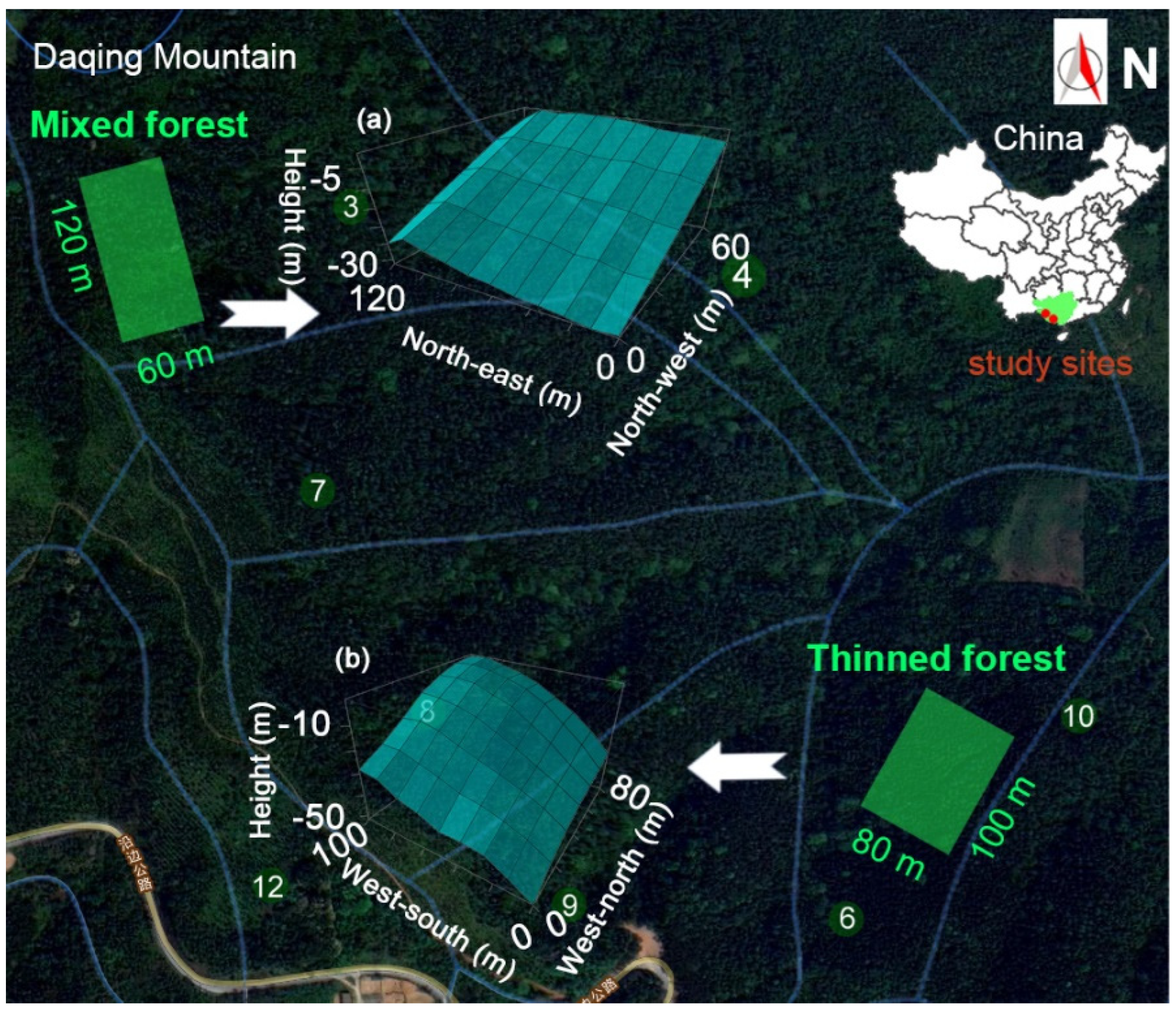
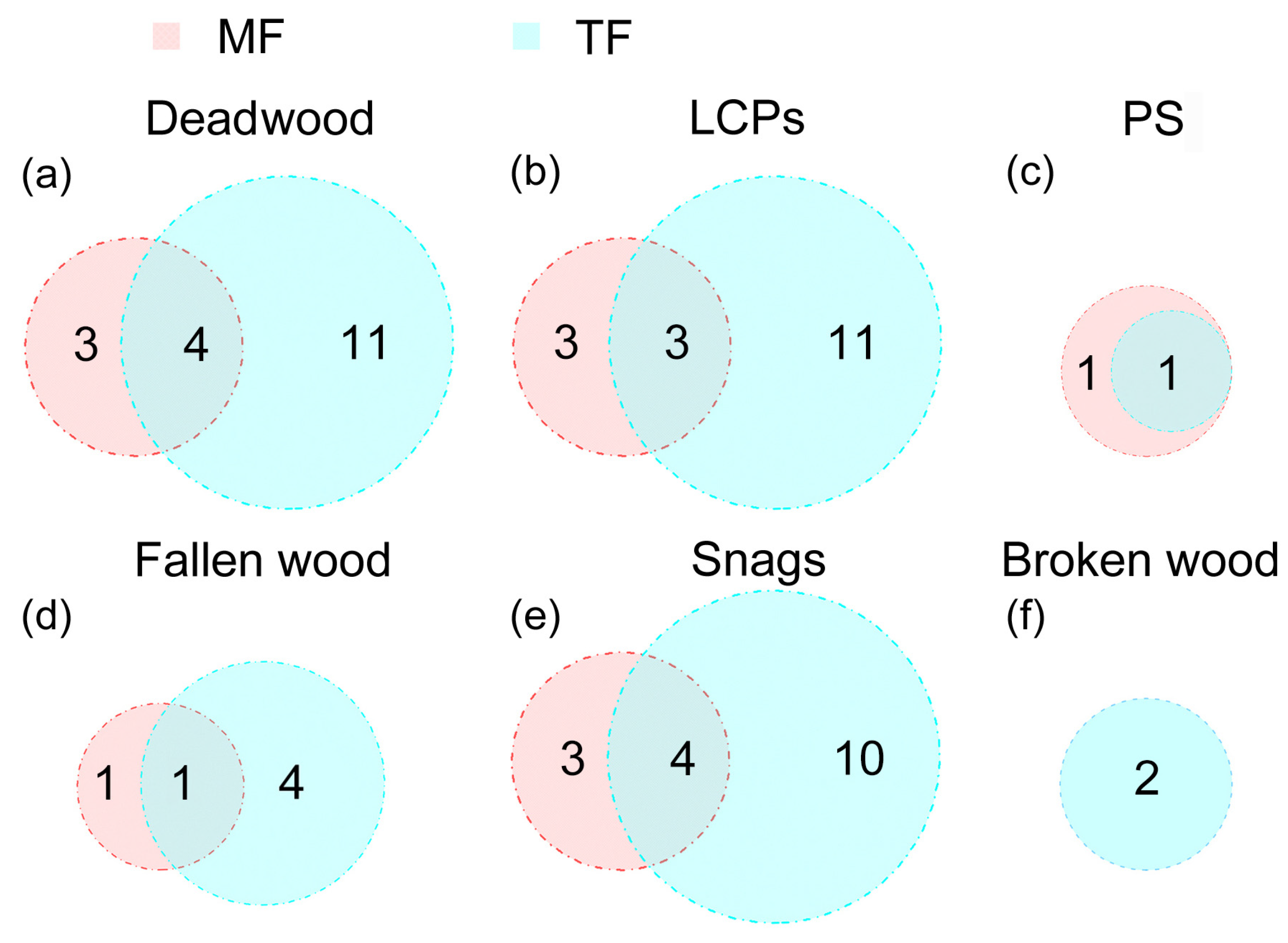
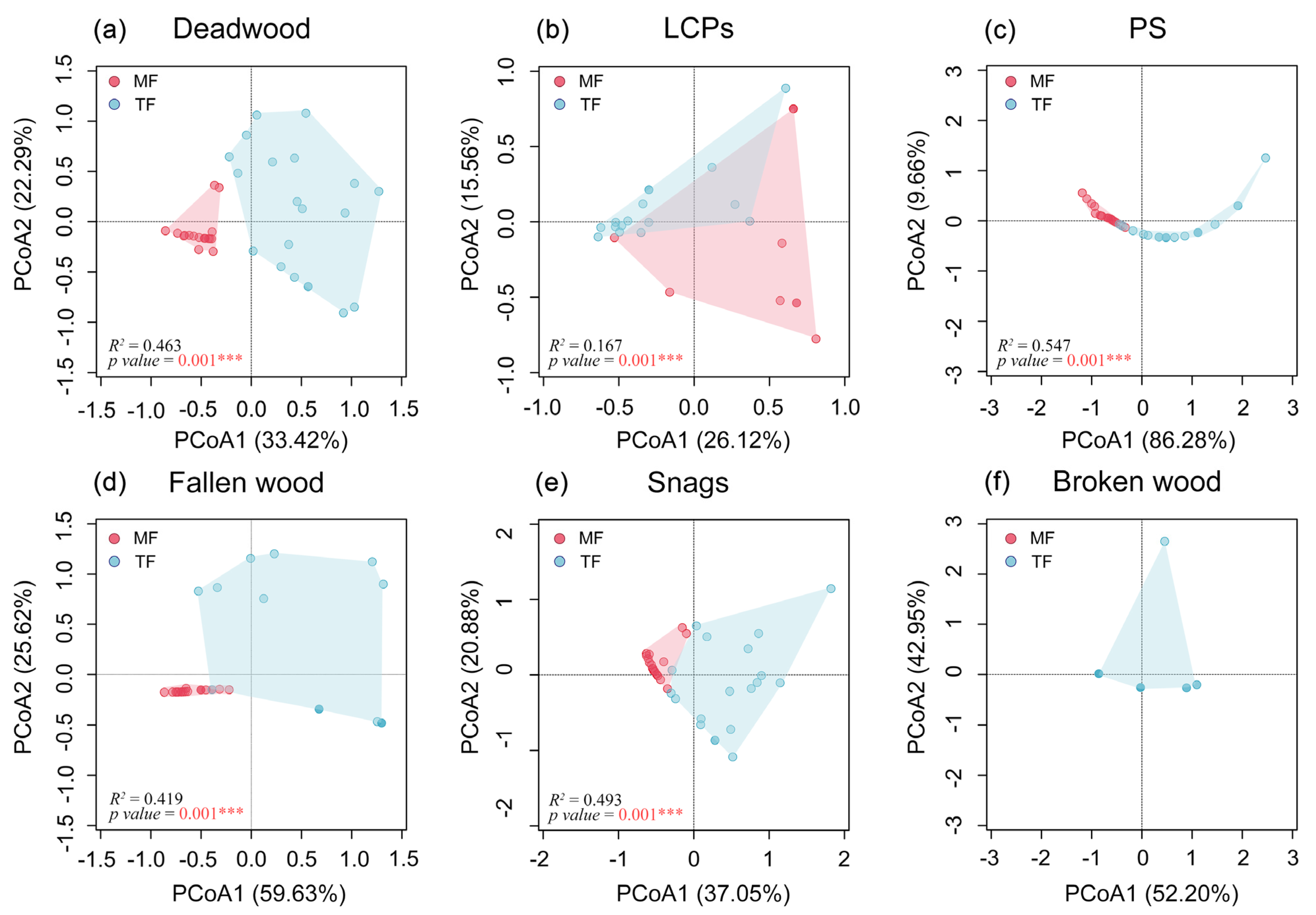
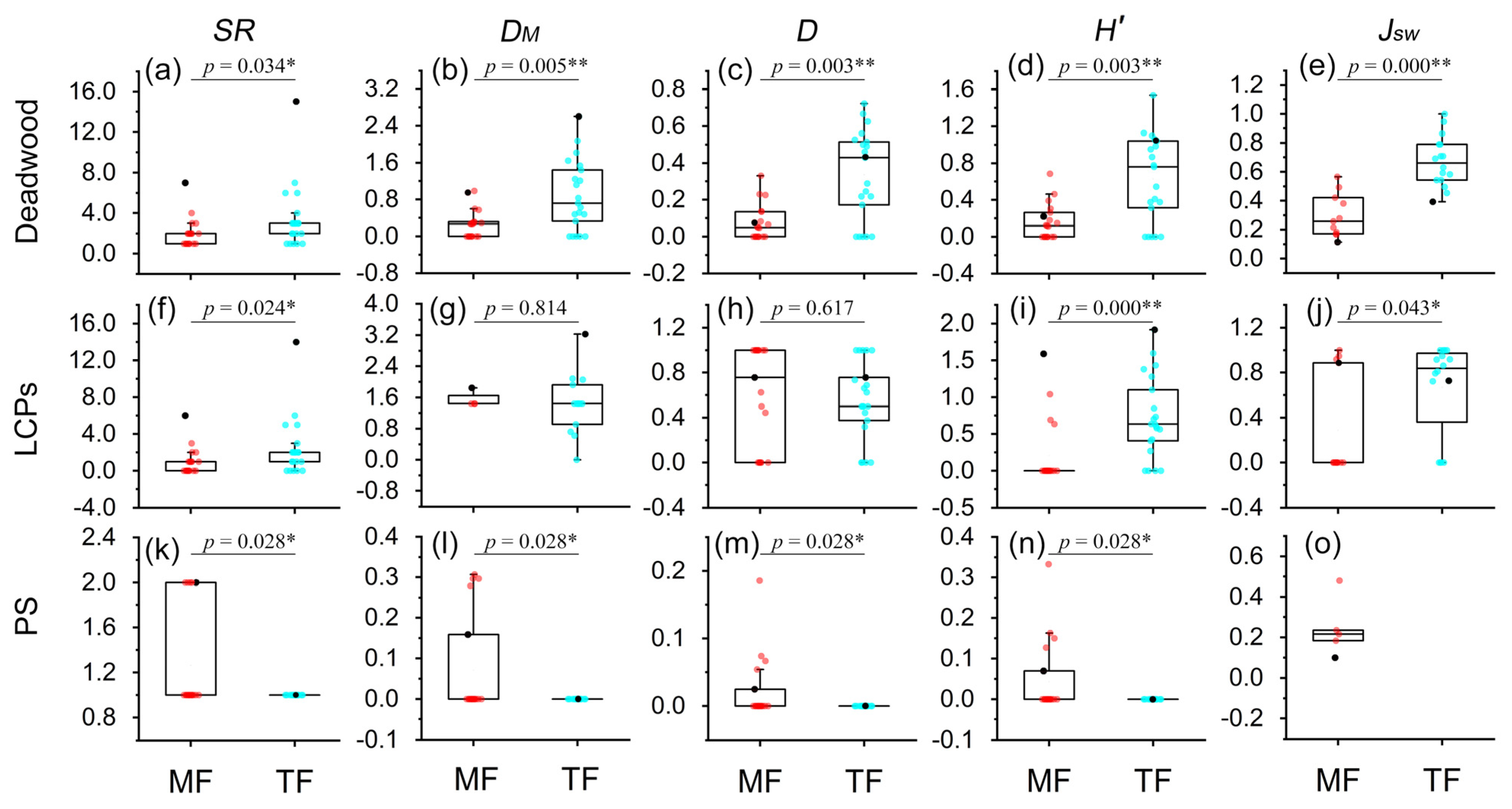
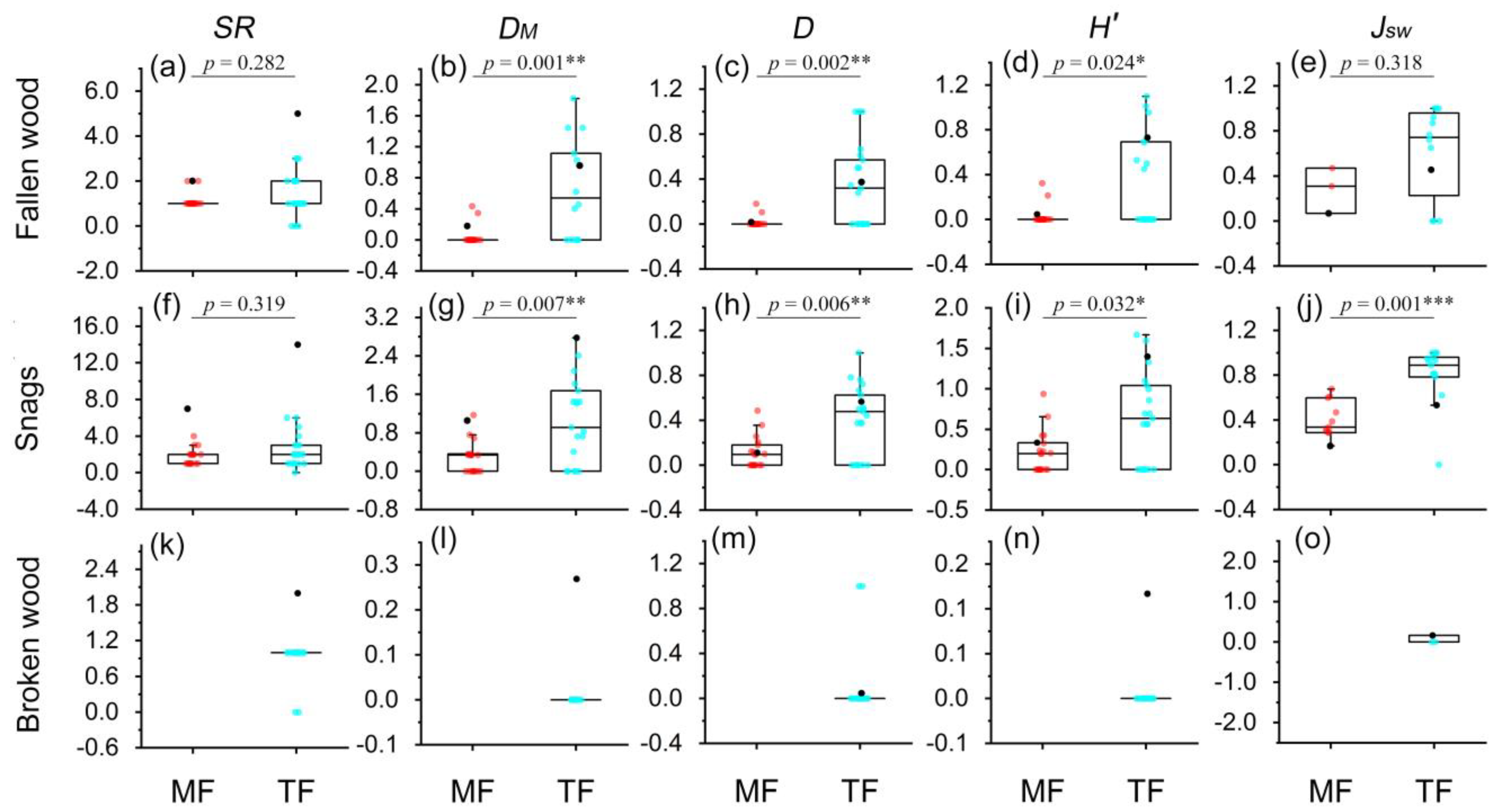
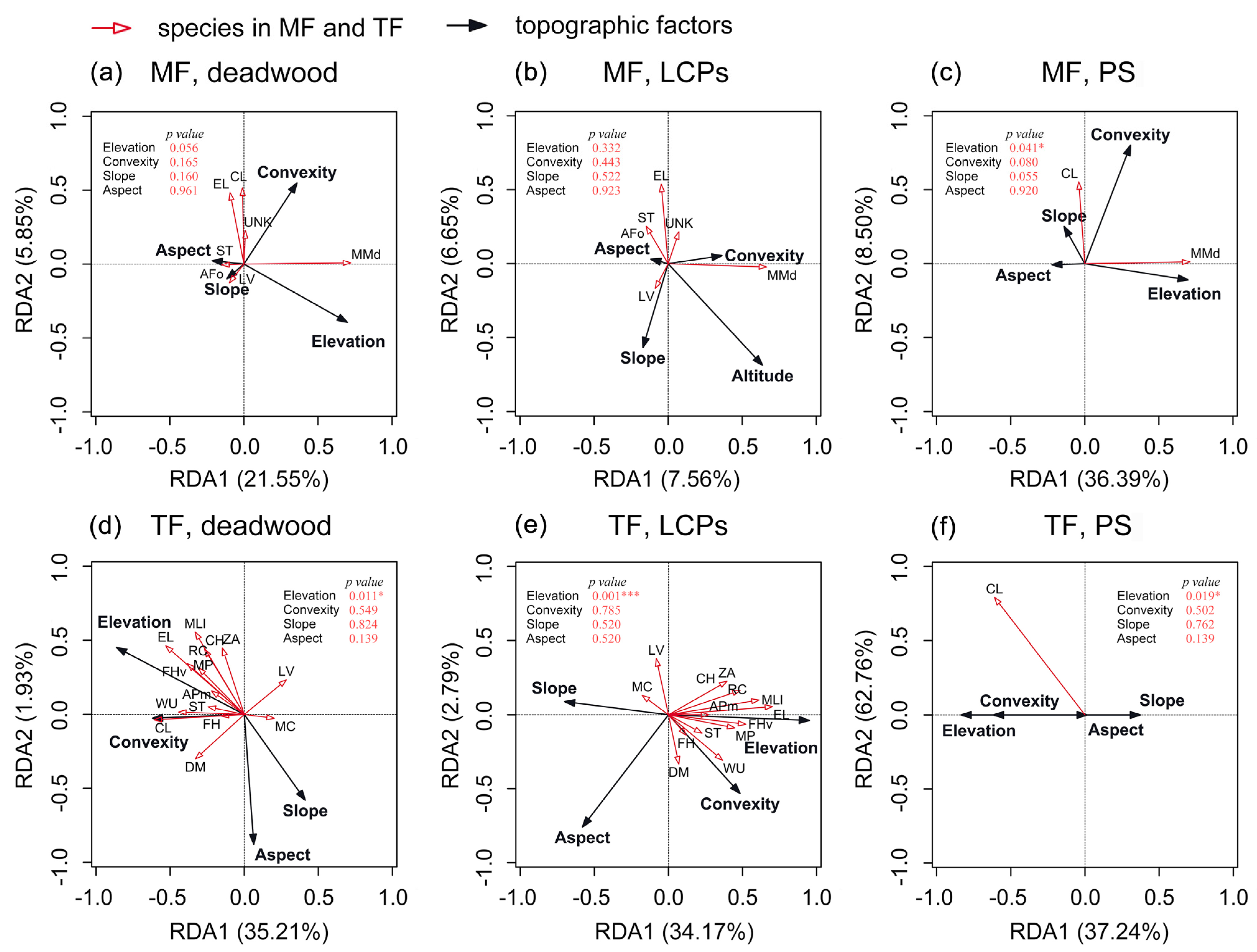

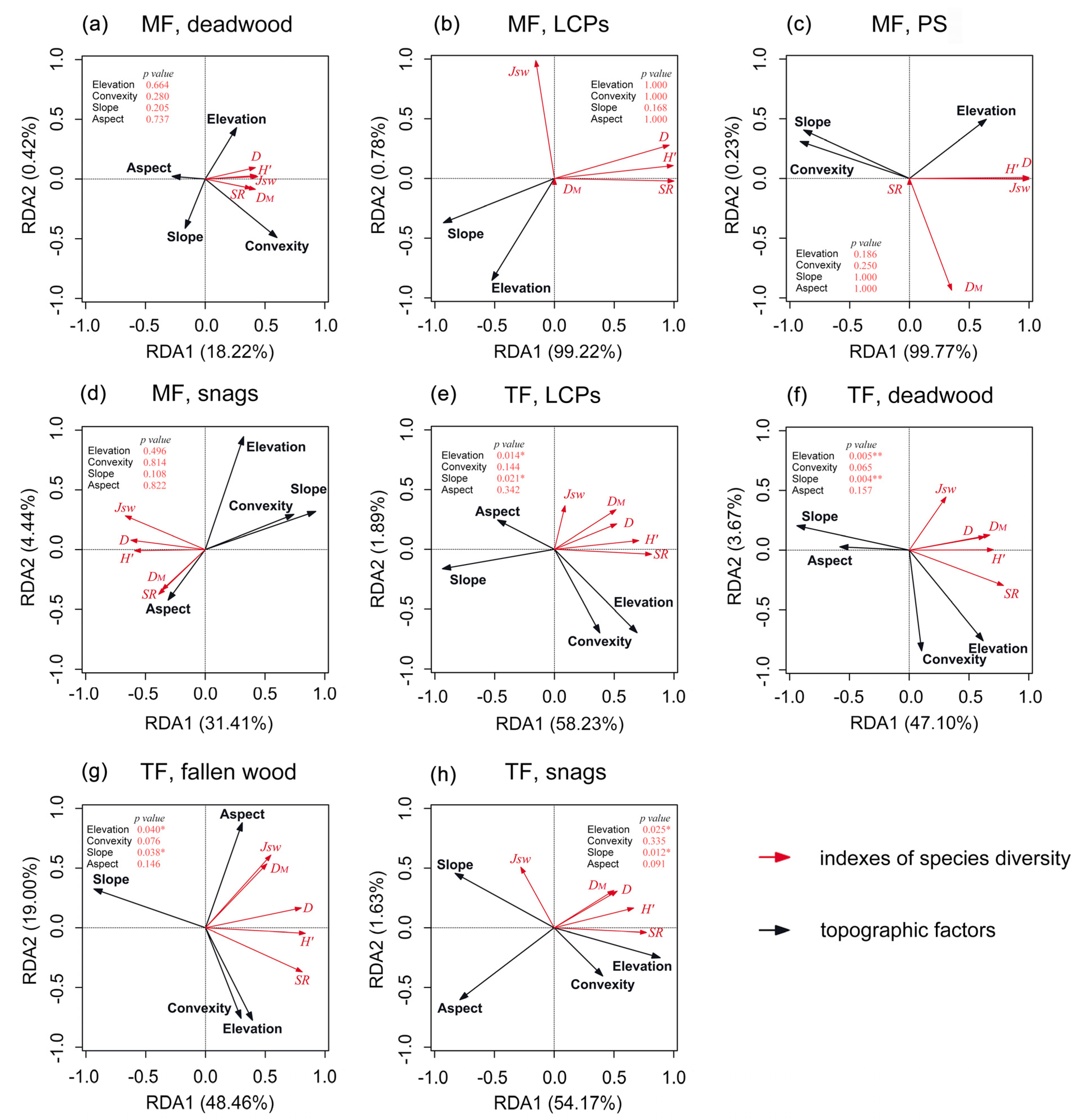
| Indices | Formulas | Explanation | References |
|---|---|---|---|
| Margalef index (DM): | SR = species richness, number of species; N = total number of individuals | [32] | |
| Simpson index (D): | Pi = relative abundance of the ith species; SR = species richness, number of species | [32] | |
| Shannon–Wiener index (H′): | Pi = relative abundance of the ith species; SR = species richness, number of species | [32] | |
| Pielou evenness index (JSW): | H′ = Shannon–Wiener index; SR = species richness, number of species | [33] |
| Stands | Origin | Family | Species | Abbreviation | N | DBH (Mean ± SD) (cm) |
|---|---|---|---|---|---|---|
| MF | LCPs | Actinidiaceae | Saurauia tristyla DC. | ST | 1 | 4.20 |
| Alangiaceae | Alangium faberi Oliv | AFo | 1 | 3.80 | ||
| Lauraceae | Litsea variabilis Hemsl. | LV | 2 | 5.15 ± 0.35 | ||
| Magnoliaceae | Michelia macclurei Dandy | MMd | 3 | 8.87 ± 3.95 | ||
| Rutaceae | Evodia lepta (Spreng.) Merr. | EL | 3 | 6.77 ± 3.66 | ||
| unknown | unknown | UNK | 6 | 7.35 ± 6.37 | ||
| PS | Magnoliaceae | Michelia macclurei Dandy | MMd | 6 | 19.02 ± 2.97 | |
| Cupressaceae | C. lanceolata | CL | 536 | 10.96 ± 3.75 | ||
| TF | LCPs | Actinidiaceae | Saurauia tristyla DC. | ST | 5 | 4.48 ± 2.19 |
| Ebenaceae | Diospyros morrisiana Hance | DM | 1 | 8.00 | ||
| Euphorbiaceae | Mallotus philippensis (Lam.) Muell. Arg. | MP | 1 | 6.80 | ||
| Fagaceae | Castanopsis hystrix Miq. | CH | 2 | 2.65 ± 0.15 | ||
| Hamamelidaceae | Mytilaria laosensis Lec. | MLl | 2 | 13.50 ± 1.50 | ||
| Lauraceae | Machilus chinensis (Champ. ex Benth.) Hemsl. | MC | 1 | 6.20 | ||
| Litsea variabilis Hemsl. | LV | 1 | 3.80 | |||
| Actinodaphne pilosa (Lour.) Merr. | APm | 1 | 4.40 | |||
| Moraceae | Ficus hirta Vahl | FHv | 2 | 2.25 ± 0.45 | ||
| Ficus hispida L. f. | FH | 4 | 2.85 ± 0.97 | |||
| Rosaceae | Rubus corchorifolius L. f. | RC | 1 | 1.20 | ||
| Rutaceae | Zanthoxylum avicennae (Lam.) DC. | ZA | 1 | 3.00 | ||
| Evodia lepta (Spreng.) Merr. | EL | 25 | 6.04 ± 3.83 | |||
| Rubiaceae | Wendlandia uvariifolia Hance | WU | 9 | 3.10 ± 0.98 | ||
| PS | Cupressaceae | C. lanceolata | CL | 162 | 13.71 ± 5.92 |
| Stands | Statuses | N | SR * | DBH (Min-Mean-Max) (cm) | Height/Length (Min-Mean-Max) (m) | Basal Area (cm2) | Volume (m3) |
|---|---|---|---|---|---|---|---|
| MF | Fallen wood | 254 | 2 | 1.5-9.5-20.0 | 1.3-5.8-14.0 | 71.2 | 14.7 |
| Snags | 304 | 7 | 2.5-12.1-25.0 | 1.3-4.8-13.0 | 114.9 | 34.7 | |
| TF | Fallen wood | 66 | 5 | 3.0-10.6-12.0 | 1.0-5.3-16.0 | 87.9 | 5.7 |
| Snags | 111 | 14 | 1.2-9.8-26.0 | 0.5-9.4-19.2 | 75.1 | 11.2 | |
| Broken wood | 41 | 2 | 4.5-17.6-21.0 | 1.3-5.1-14.0 | 242.7 | 11.9 |
Disclaimer/Publisher’s Note: The statements, opinions and data contained in all publications are solely those of the individual author(s) and contributor(s) and not of MDPI and/or the editor(s). MDPI and/or the editor(s) disclaim responsibility for any injury to people or property resulting from any ideas, methods, instructions or products referred to in the content. |
© 2023 by the authors. Licensee MDPI, Basel, Switzerland. This article is an open access article distributed under the terms and conditions of the Creative Commons Attribution (CC BY) license (https://creativecommons.org/licenses/by/4.0/).
Share and Cite
Li, M.; Li, Y.; Ye, S.; Hao, J.; Zhang, L. Species Diversity of Deadwood in Chinese Fir Plantations Differs between Mixed Planting and Thinning Treatments. Sustainability 2023, 15, 9214. https://doi.org/10.3390/su15129214
Li M, Li Y, Ye S, Hao J, Zhang L. Species Diversity of Deadwood in Chinese Fir Plantations Differs between Mixed Planting and Thinning Treatments. Sustainability. 2023; 15(12):9214. https://doi.org/10.3390/su15129214
Chicago/Turabian StyleLi, Muxuan, Yuanfa Li, Shaoming Ye, Jian Hao, and Lianjin Zhang. 2023. "Species Diversity of Deadwood in Chinese Fir Plantations Differs between Mixed Planting and Thinning Treatments" Sustainability 15, no. 12: 9214. https://doi.org/10.3390/su15129214
APA StyleLi, M., Li, Y., Ye, S., Hao, J., & Zhang, L. (2023). Species Diversity of Deadwood in Chinese Fir Plantations Differs between Mixed Planting and Thinning Treatments. Sustainability, 15(12), 9214. https://doi.org/10.3390/su15129214






